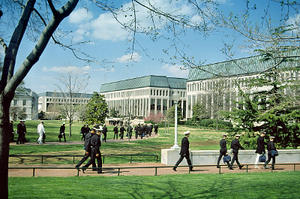CybersecurityU.S. Naval Academy to launch cyber security center
The building and labs would cost $100 million, with work beginning in 2014; a Baltimore lawmaker who also is chairman of a House subcommittee that deals with technical and tactical intelligence says: “The future of war fighting is cyber security… We [the United States] have been cyber-attacked on a regular basis; our future leaders need to understand cyber security”

U.S. Naval Academy at Annapolis, MD // Source: wikimedia.org
The Naval Academy wants to build a $100 million Cyber Security Studies center beginning in 2014, academy officials told the Board of Visitors last week. Speaking at a regular quarterly meeting, Hometown Annapolis’s Earl Kelly writes that Academic Dean Andrew Phillips said the new center is needed to train junior officers for a world in which attacks on computer systems will be the war of the future.
If approved by the Pentagon and funded by Congress, the new building would cost between $80 million and $100 million and would likely be between Nimitz Library and Rickover Hall, Phillips said.
Because of the budgeting process, fiscal 2014 would be the earliest that work could begin on the project, he said.
Phillips said the academy needs more lab space in general because engineering instructors assign midshipmen group research projects that go beyond the classroom. “If we want to continue moving forward with our emphasis on science and engineering project-based learning, and if we want to create a new program to support cyber security … and if the Navy wants us to do that here at the Naval Academy and to do it well, we need to build a new building,” Phillips said, laying out the reasons to construct the new center.
“The physical infrastructure built nearly 40 years ago to support the engineering component of the academy was simply never designed to support what we are attempting to do today,” Phillips said.
Many of the board members found Phillips’s comments encouraging, especially Rep. C. A.“Dutch” Ruppersberger (D-Baltimore County). Ruppersberger, who is on the House Appropriations Committee, one of the committees that controls spending, called the new building “very important.”
“The future of war fighting is cyber security,” said Ruppersberger, who also is chairman of a House subcommittee that deals with technical and tactical intelligence. “We (the United States) have been cyber-attacked on a regular basis; our future leaders need to understand cyber security,” Ruppersberger said.
Many details must be ironed out concerning the proposed center, including whether it would have a secured area, often called a sensitive compartmented information facility.
Currently, the Naval Academy’s facilities do not deal with classified information, and having such a center could affect the public’s access to the campus, or Yard. “We want this to be an open institution, open to tours, but you might have to isolate that area of the Yard,” Superintendent Vice Adm. Jeffrey L. Fowler said.
Phillips, whose background is math and computer science, taught at the academy from 1988 to 1998, and returned in mid-2009 as academic dean.
The academy announced in December that it was creating the Center for Cyber Security Studies, which will allow some midshipmen to major in cyber defense. It also will help give all mids some training in the field.
Phillips announced that the academy has named Cmdr. Steven J. Simon as the center’s director.
Simon, who will assume his new post this summer, is slated for promotion to captain. He currently serves as commander of the Naval Communications Material Security System at Andrews Air Force Base. Simon holds a doctorate in information systems and international business from the University of South Carolina.
Admissions up
The freshman, or plebe, class that will enter the Naval Academy today (Thursday) was chosen from the largest applicant pool in academy history, officials said yesterday. The academy received 17,417 applications for about 1,230 seats in the Class of 2014, Dean of Admissions Bruce Latta told the board. In contrast, Latta noted, the Class of 2002 had about 9,800 applicants.
Nearly one-third of this year’s applications, or 5,379, came from minority students, Latta said.
